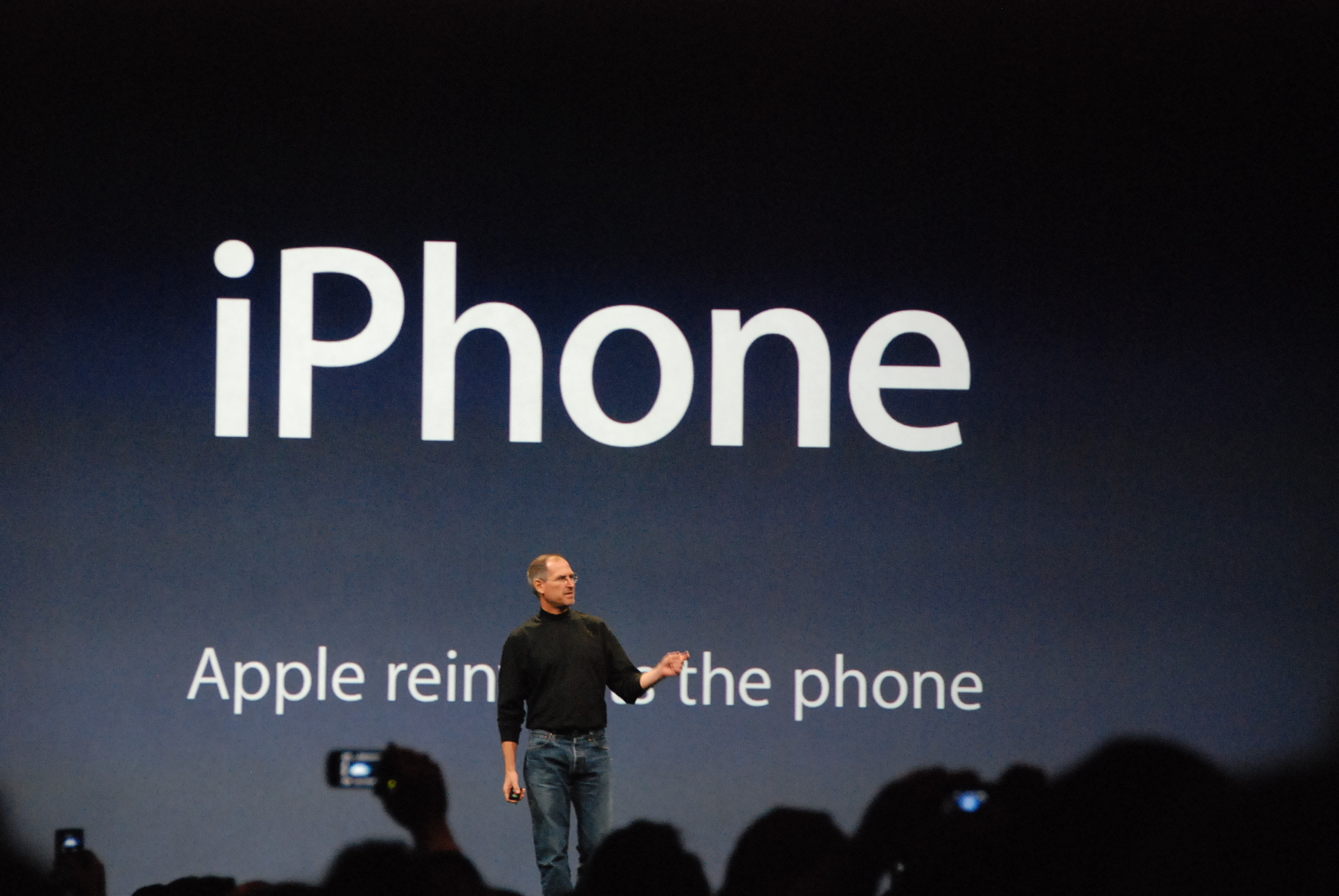By Justin Chiu
Translation: Lawrence Myers
Passage au crible n°116
 Source: Flickr
Source: Flickr
On September 9, 2014, high-tech journalists from around the globe as well as the general press gathered at the Flint Center in Cupertino to attend the presentation of the iPhone 6. Led by Apple’s general manager, Tim Cook, and broadcast on the Internet, this great event was acclaimed by numerous celebrities, such as Gwen Stefani and Dr. Dre, who arrived in a private jet, and Coco Lee, a singer popular in Asia, whose arrival was even announced on the band’s official website. Lacking significant innovations, the iPhone 6 was, nonetheless, warmly welcomed by the public at the Flint Center.
> Historical background
> Theoretical framework
> Analysis
> References
It was in the same mythic room in 1984 that Steve Jobs had presented the very first Mac computer. With a subtle mixture of humor and superlatives, the founder of Apple excited the shareholders participating in the event. Incited by the original soundtrack of the film Chariots of Fire, the audience roared and applauded at the end of the presentation. Since then, the Cupertino Company has not only provided an insanely great product – the formula for the presentation – but also an extraordinary experience. In this sense, users of Apple products always expect a unique experience and are willing to spend more in order to get it.
With the iPod in 2001, Apple launched into the very competitive consumer electronics market. Clearly positioned as a high-end product, Apple’s audio player appeared as an object to be desired, even a symbol of leisure for the middle class. Moreover, the product was intended for use with iTunes installed on a computer. In doing this, the professional use of Mac combines with the more leisurely use of the iPod. According to this logic, costumer fidelity vis-à-vis Apple products grew considerably with a more intensive utilization. Besides that, from year to year the keynote speech, led by Steve Jobs, has become a must for the Apple community.
In 2007, Steven Jobs presented the first generation iPhone, a product that he himself qualified as revolutionary. Since then, ten models have followed. In 2013, Apple became the second most popular smartphone on the planet behind Samsung, delivering 153.4 million devices. Nonetheless, with 15.3% of the market, Apple succeeded in clearing 60% of the profit, in other words, 129 billion dollars (research firm Asymco). Facing market newcomers, Apple has chosen to no longer maintain its low price strategy. On the contrary, the two models, the iPhone 6 and the iPhone 6 plus are proving to be more luxurious than ever; the most costly model, exceeding the symbolic price ceiling of 1,000 euros.
1. The global construction of a media event. Since the launching of the first iPhones, Apple’s press conferences have become veritable planetary spectacles. Formerly led by the charismatic Steve Jobs, then by the general manager, Tim Cook, from now on these ceremonies are simultaneously broadcast on the Internet, serving to show the economic and cultural strength of the company as well as its ability to attract journalists and consumers from around the globe. Despite a relaxed atmosphere, these presentations are meticulously prepared. Nothing is left to chance: each image, each gesture is calculated and codified in order to create an extraordinary atmosphere.
2. The intensive diffusion of incremental innovations. Far from being a revolutionary product, the iPhone 6 only offers two major improvements compared to previous versions: a more powerful processor and a larger screen. Nevertheless, the Apple’s strength lies precisely in its talent to constantly produce better terminals and to diversify its activities. Not only do smartphone techniques benefit from improvement, but so do production structure and product services. If above all else the digital revolution is experiencing a “technological acceleration” (Lorenzi), it is therefore necessary to analyze how Apple has built its ecosystem with its line of iPhones.
The nature of Apple’s keynote is proving to be deeply different from other events taking place on a global scale. Such events are indeed organized either by the states, like royal weddings, or by inter-state organizations, like the Olympic Games. On the other hand, here a private actor, a company, has designed a show by mobilizing all of its financial and symbolic resources that extend beyond its borders. In thirty years, Apple has succeeded in institutionalizing its press conferences, from now long anticipated appointments. The personality of Steve Jobs contributed much to this end; his charisma and talent for convincing were intimately connected to the reputation of the brand. Journalists and celebrities remain in a state of permanent anticipation that these events will fascinate them, to the point that they are captivated before the conference even begins. In this sense, acquiring an iPhone entails displaying one’s superior social status; exhibiting this object of desire is akin to ostentatiously mobilizing a symbol of power.
Apple product users seek a personal and special experience. They identify with it because among all smartphone manufacturers, only Apple presents itself as a high-end brand. This strategy allows it to assure a considerable margin all the while masterfully securing the loyalty of its buyers. With a system operating exclusively via iTunes and the App Store, one must acquire a Mac, an iPhone and an iPad in order to fully benefit from the optimal functions of its terminals. As a result, fearing the slightest dysfunction or incapability, even dreading exclusion from the Apple community, fans rarely envision abandoning the brand.
Like all capitalistic organizations, Apple innovates in order to garner more profit. However, in the context of the global deregulation of telecommunications, competition has grown with low-cost Chinese firms, like Huawei and Xiaomi. In so doing, the actors in this sector are investing more and more in applied research and favoring short-term projects to the detriment of fundamental research. Bearing this in mind, manufacturers constantly renew their product lines without having made any significant discoveries. Thus, we observe the continued decreasing of a smartphone’s life span, while consumers feel obligated to acquire the latest model. Nonetheless, with the accumulation of small innovations in the last decade, the smartphone has considerably transformed our way of life.
During the presentation of the iPhone 6, the contactless payment service, Apple Pay, was also introduced. Used until now by Samsung and Sony without any great success, this payment technique will finally be generalized with this new model. Since the successive launching of the iPod, the iPhone and the iPad, it must be noted that Apple masters not only the diffusion of new techniques, but can also count on the fidelity of its users, ready to live the Apple experience.
Chiu Justin, « L’anarchie mondiale dans la téléphonie mobile », in : Josepha Laroche (Éd.), Passage au crible, l’actualité internationale 2012, Paris, L’Harmattan, 2013, pp. 117-122.
Dayan Daniel, Katz Elihu, La Télévision cérémonielle : anthropologie et histoire en direct, trad., Paris, PUF, 1996.
Le Monde, « La grande et les petites révolutions d’Apple », 11 sept. 2014.
Lorenzi Jean-Hervé et Villemeur Alain (Éds.), L’Innovation au cœur de la nouvelle croissance, Paris, Economica, 2009.
Strange Susan, Mad Money, Manchester, Manchester University Press, 1998.
Strange Susan, States and Markets: An Introduction to International Political Economy, Londres, Pinter, 2e éd, 1994.
Veblen Thorstein, The Theory of the Leisure Class, [1899], New York, Dover Publications, 1994.




